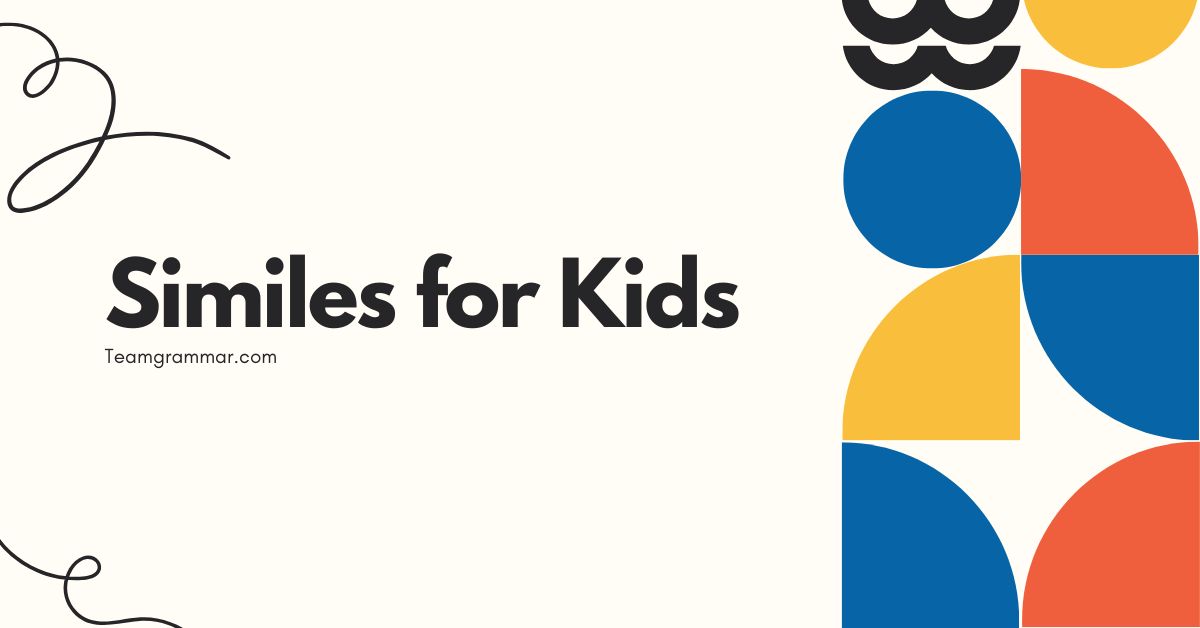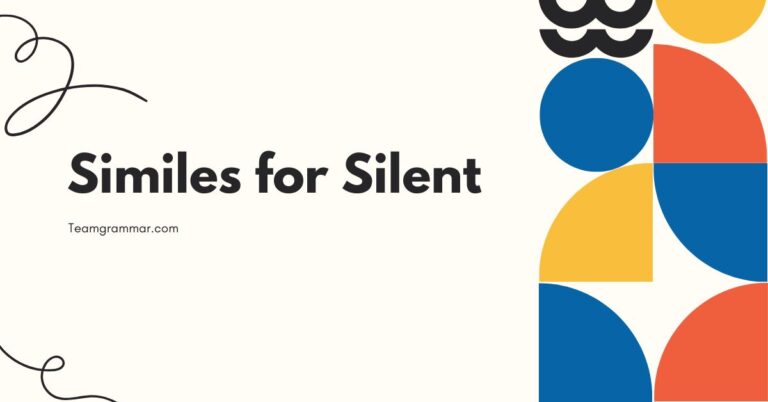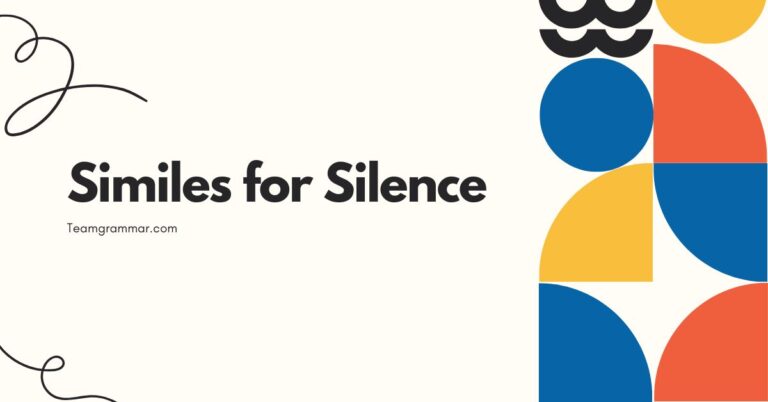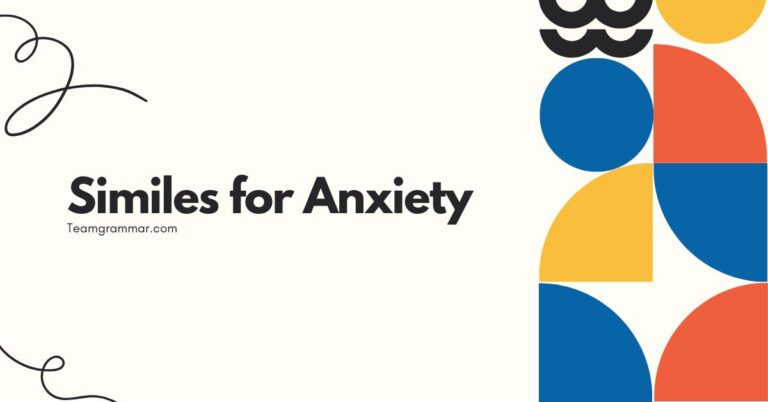45 Similes for Kids: Making Writing Fun and Descriptive
Similes are a fantastic way to make writing more exciting and vivid. They help us compare two different things using words like “like” or “as,” allowing us to create a clearer and more interesting picture in the reader’s mind.
Understanding similes is crucial for young learners as it enhances their descriptive writing skills, boosts their creativity, and improves their overall comprehension of language. This article is designed for elementary and middle school students, parents, and educators who want to explore the wonderful world of similes and make learning grammar enjoyable.
Table of Contents
- Introduction
- What is a Simile?
- Structural Breakdown of a Simile
- Types of Similes
- Examples of Similes
- Usage Rules for Similes
- Common Mistakes with Similes
- Practice Exercises
- Advanced Topics: Expanding Simile Use
- Frequently Asked Questions
- Conclusion
What is a Simile?
A simile is a figure of speech that compares two unlike things using the words “like” or “as.” It helps to create a vivid image in the reader’s mind by highlighting a similarity between the two things being compared. The main purpose of a simile is to make descriptions more interesting and engaging.
Similes function as a tool to enrich language, making it more colorful and expressive. They are used in various contexts, from everyday conversations to literature and poetry.
By using similes, writers and speakers can make their ideas more relatable and understandable.
Think of it like this: a simile is like adding sprinkles to an ice cream cone. The ice cream is good on its own, but the sprinkles make it even better and more fun!
Similarly, a sentence is fine, but a simile makes it more descriptive and engaging.
Structural Breakdown of a Simile
The structure of a simile is quite simple. It typically consists of two parts: the **subject** being described and the **object** it’s being compared to, connected by the words “like” or “as.” Understanding this structure helps in creating and identifying similes effectively.
The basic formula for a simile is: Subject + “like” or “as” + Object. For example, in the simile “The sun is like a giant orange,” the subject is “the sun,” and it’s being compared to “a giant orange.” The word “like” connects the two.
Let’s break it down further with another example: “She sings as beautifully as a nightingale.” Here, “she” is the subject, and she is being compared to “a nightingale.” The connecting phrase is “as beautifully as.” It’s important to note that the comparison highlights a specific quality—in this case, beauty in singing.
Types of Similes
While all similes use “like” or “as” to make a comparison, they can be categorized based on what they emphasize. Here are a few common types of similes:
Descriptive Similes
These similes focus on describing a particular quality or characteristic. They help the reader visualize or understand the subject better by comparing it to something familiar.
Example: “Her hair was as golden as the sun.” This simile emphasizes the color of her hair, making it easier for the reader to imagine.
Action Similes
Action similes compare the way something moves or behaves to something else. They often use verbs to show the similarity in action.
Example: “He ran like the wind.” This simile describes how fast he was running by comparing it to the speed of the wind.
Emotional Similes
Emotional similes express feelings or emotions by comparing them to something else. They help the reader understand the intensity or nature of the emotion.
Example: “She felt as light as a feather.” This simile conveys the feeling of happiness or relief.
Examples of Similes
Here are some examples of similes, categorized to help you understand their usage better. These examples cover a range of topics and situations, demonstrating the versatility of similes in enriching language.
General Similes
These similes are commonly used in everyday language to make simple comparisons.
The table below includes 30 general examples of similes:
| Simile | Explanation |
|---|---|
| As brave as a lion | Describes someone who is very courageous. |
| As quiet as a mouse | Describes someone who is very silent. |
| As busy as a bee | Describes someone who is very active and hardworking. |
| As strong as an ox | Describes someone who is very powerful. |
| As light as a feather | Describes something that is very weightless. |
| As cold as ice | Describes something that is very chilly or someone who is unemotional. |
| As clear as crystal | Describes something that is very transparent or easy to understand. |
| As different as night and day | Describes things that are completely opposite. |
| As gentle as a lamb | Describes someone who is very kind and mild. |
| As hungry as a wolf | Describes someone who is very hungry. |
| As tall as a tree | Describes someone or something that is very tall. |
| As slow as a snail | Describes someone or something that is very slow. |
| As fast as lightning | Describes something that is very quick. |
| As sweet as honey | Describes something that is very pleasant or kind. |
| As stubborn as a mule | Describes someone who is very obstinate. |
| As wise as an owl | Describes someone who is very knowledgeable and insightful. |
| As playful as a kitten | Describes someone who is very lively and fun-loving. |
| As smooth as silk | Describes something that is very soft and sleek. |
| As sharp as a tack | Describes someone who is very intelligent and alert. |
| As nutty as a fruitcake | Describes someone who is eccentric or silly. |
| Like two peas in a pod | Describes two people who are very similar. |
| Like a fish out of water | Describes someone who is uncomfortable in a new situation. |
| Like a deer caught in headlights | Describes someone who is startled or frightened. |
| Like a bull in a china shop | Describes someone who is clumsy or careless. |
| Like a broken record | Describes someone who repeats themselves constantly. |
| As alike as two drops of water | Describes things that are very similar. |
| As easy as pie | Describes something that is very easy to do. |
| As flat as a pancake | Describes something that is very flat. |
| As pale as a ghost | Describes someone who is very pale, usually from fear or illness. |
| As clear as mud | Describes something that is not at all clear and very confusing (often used ironically). |
Similes Describing Appearance
These similes focus on physical attributes and appearances.
The table below includes 25 examples of similes describing appearance:
| Simile | Explanation |
|---|---|
| Her eyes were like sparkling diamonds. | Emphasizes the brightness and beauty of her eyes. |
| His skin was as smooth as silk. | Highlights the softness and texture of his skin. |
| Her hair was like a raven’s wing. | Describes the dark and shiny color of her hair. |
| He was as thin as a rail. | Describes someone who is very skinny. |
| Her smile was as bright as the sun. | Emphasizes the radiance and warmth of her smile. |
| His beard was like a tangled forest. | Describes a beard that is thick and unkempt. |
| Her dress flowed like water. | Describes the smooth and graceful movement of her dress. |
| His muscles were as hard as rocks. | Describes someone who is very muscular and strong. |
| Her voice was as clear as a bell. | Emphasizes the clarity and pleasantness of her voice. |
| His hands were like rough sandpaper. | Describes hands that are coarse and textured. |
| She was as radiant as the moon. | Describes someone who is glowing and beautiful. |
| His face was like a weathered map. | Describes a face that is lined and shows age or experience. |
| Her laughter was like tinkling bells. | Emphasizes the light and cheerful sound of her laughter. |
| His eyes were as blue as the ocean. | Describes the deep blue color of his eyes. |
| Her skin was as pale as snow. | Describes very fair skin. |
| His hair was like spun gold. | Describes golden and fine hair. |
| She moved like a graceful swan. | Describes someone moving with elegance and poise. |
| His stature was as imposing as a mountain. | Describes someone who is tall and commanding. |
| Her presence was like a breath of fresh air. | Describes someone who is refreshing and welcome. |
| His gaze was as sharp as an eagle’s. | Describes someone with a piercing look. |
| She dressed like a queen. | Describes someone who dresses elegantly and regally. |
| His teeth were as white as pearls. | Describes very white and shiny teeth. |
| Her figure was like an hourglass. | Describes a curvy and well-proportioned figure. |
| He stood as firm as an oak. | Describes someone standing strong and unyielding. |
| She aged like fine wine. | Describes someone who gets better with age. |
Similes Describing Feelings
These similes help express emotions and feelings in a more relatable way.
The table below includes 25 examples of similes describing feelings:
| Simile | Explanation |
|---|---|
| He felt as nervous as a cat in a room full of rocking chairs. | Describes extreme nervousness and unease. |
| She was as happy as a clam. | Describes a state of perfect happiness and contentment. |
| He felt like a fish out of water. | Describes feeling uncomfortable and out of place. |
| She was as angry as a hornet. | Describes someone who is very angry and irritable. |
| He felt as light as a feather. | Describes feeling happy and carefree. |
| She was as sad as a rainy day. | Describes a feeling of sadness and gloom. |
| He felt like he was walking on air. | Describes feeling extremely happy and excited. |
| She was as scared as a mouse. | Describes someone who is very frightened. |
| He felt like he had won the lottery. | Describes feeling extremely lucky and overjoyed. |
| She was as lonely as a cloud. | Describes a feeling of isolation and solitude. |
| He felt as free as a bird. | Describes a feeling of liberation and independence. |
| She was as excited as a kid in a candy store. | Describes extreme excitement and eagerness. |
| He felt like he was on top of the world. | Describes feeling extremely successful and powerful. |
| She was as calm as a still lake. | Describes a state of peace and tranquility. |
| He felt like he was carrying the weight of the world on his shoulders. | Describes feeling burdened and overwhelmed. |
| She was as surprised as if she’d seen a ghost. | Describes a feeling of shock and disbelief. |
| He felt as awkward as a penguin in the desert. | Describes feeling very out of place and uncomfortable. |
| She was as peaceful as a sleeping baby. | Describes a state of serene calmness. |
| He felt like he was running in circles. | Describes feeling frustrated and unproductive. |
| She was as nervous as a long-tailed cat in a room full of rocking chairs. | Another way to describe extreme nervousness. |
| He felt like a million bucks. | Describes feeling great and confident. |
| She was as blue as the sky on a sad day. | Describes a feeling of deep sadness or depression. |
| He felt like he was floating on a cloud. | Describes a feeling of bliss and happiness. |
| She was as content as a cat in a sunbeam. | Describes a feeling of perfect satisfaction and comfort. |
| He felt like he had been hit by a truck. | Describes feeling exhausted and overwhelmed. |
Usage Rules for Similes
Using similes correctly involves understanding a few key rules. These rules ensure that your similes are effective and make sense in the context of your writing or speech.
1. Compare Unlike Things:A simile should compare two things that are different but share a common quality.
For example, comparing “the sun” to “a giant orange” works because they are both round and bright.
2. Use “Like” or “As”:These are the key words that signal a simile.
Make sure to include one of them in your comparison.
3. Ensure Clarity:The comparison should be clear and easy to understand.
Avoid using obscure or confusing references.
4. Maintain Consistency:The qualities you are comparing should be consistent.
For example, if you’re comparing the speed of something, make sure the object you’re comparing it to is also known for its speed.
5. Avoid Clichés:While some similes are common, try to avoid overused clichés.
Instead, aim for fresh and original comparisons that will make your writing stand out.
Common Mistakes with Similes
Even with a good understanding of similes, it’s easy to make mistakes. Here are some common errors and how to correct them:
1. Confusing Similes with Metaphors: A simile uses “like” or “as” to compare, while a metaphor directly states that one thing *is* another.
* Incorrect (Metaphor): “The sun is a giant orange.”
* Correct (Simile): “The sun is like a giant orange.”
2. Comparing Similar Things: A simile should compare unlike things, not things that are already similar.
* Incorrect: “My dog is like a dog.”
* Correct: “My dog is as playful as a puppy.”
3. Unclear Comparisons: The comparison should be easy to understand.
* Incorrect: “The book was like a glockenspiel.” (Unless the reader knows exactly what a glockenspiel sounds like and how it relates to the book).
* Correct: “The book was as captivating as a thrilling movie.”
4. Overusing Clichés: Using the same old similes can make your writing boring.
* Cliché: “As red as a rose.”
* Better: “As red as a freshly painted fire engine.”
Practice Exercises
Test your understanding of similes with these practice exercises. Each exercise includes multiple questions to help reinforce your learning.
Exercise 1: Identifying Similes
Identify the similes in the following sentences. Underline the simile and explain what two things are being compared.
| Question | Answer |
|---|---|
| 1. The snow was as white as milk. | The snow was as white as milk. Snow is being compared to milk to emphasize its whiteness. |
| 2. He ran like the wind. | He ran like the wind. His running speed is being compared to the speed of the wind. |
| 3. Her voice was as smooth as silk. | Her voice was as smooth as silk. Her voice is being compared to silk to emphasize its smoothness. |
| 4. The baby slept like a log. | The baby slept like a log. The baby’s deep sleep is being compared to the stillness of a log. |
| 5. The stars were like diamonds in the sky. | The stars were like diamonds in the sky. The stars are being compared to diamonds to emphasize their brightness. |
| 6. The cookies were as hard as rocks. | The cookies were as hard as rocks. The hardness of the cookies are being compared to rocks. |
| 7. The students were as quiet as mice during the test. | The students were as quiet as mice during the test. The silence of the students is being compared to the silence of mice. |
| 8. The joke was as dry as the desert. | The joke was as dry as the desert. The lack of humor in the joke is being compared to the dryness of the desert. |
| 9. The detective was as sly as a fox. | The detective was as sly as a fox. The detective’s slyness is being compared to the slyness of a fox. |
| 10. The pizza was as hot as the sun. | The pizza was as hot as the sun. The heat of the pizza is being compared to the heat of the sun. |
Exercise 2: Completing Similes
Complete the following similes with an appropriate comparison.
| Question | Answer |
|---|---|
| 1. As tall as _______________ | As tall as a skyscraper |
| 2. As bright as _______________ | As bright as the sun |
| 3. As sweet as _______________ | As sweet as candy |
| 4. As fast as _______________ | As fast as a cheetah |
| 5. As soft as _______________ | As soft as a cloud |
| 6. As heavy as _______________ | As heavy as an elephant |
| 7. As loud as _______________ | As loud as thunder |
| 8. As brave as _______________ | As brave as a soldier |
| 9. As colorful as _______________ | As colorful as a rainbow |
| 10. As deep as _______________ | As deep as the ocean |
Exercise 3: Writing Your Own Similes
Write a simile for each of the following subjects.
| Subject | Simile |
|---|---|
| 1. A happy child | A happy child is like a bird singing in the morning. |
| 2. A scary movie | A scary movie is like a rollercoaster ride in the dark. |
| 3. A delicious meal | A delicious meal is like a warm hug on a cold day. |
| 4. A difficult test | A difficult test is like climbing a steep mountain. |
| 5. A beautiful song | A beautiful song is like a gentle breeze on a summer evening. |
| 6. A crowded bus | A crowded bus is like a can of sardines. |
| 7. A boring class | A boring class is like watching paint dry. |
| 8. A fun game | A fun game is like a treasure hunt with friends. |
| 9. A good friend | A good friend is like a sturdy tree in a storm. |
| 10. A bright idea | A bright idea is like a lightbulb turning on in your head. |
Advanced Topics: Expanding Simile Use
For advanced learners, exploring more complex aspects of similes can enhance their writing skills further. This section delves into using similes in creative writing and understanding the nuances of simile construction.
1. Combining Similes:You can combine multiple similes in a single sentence or paragraph to create a richer and more detailed description.
For example, “Her laughter was like tinkling bells, as bright as the summer sun, filling the room with warmth.”
2. Subverting Expectations:Try creating similes that are unexpected or humorous by comparing things in unusual ways.
For example, “His explanation was as clear as mud,” which uses irony to convey confusion.
3. Using Similes in Poetry:Similes are a powerful tool in poetry for creating imagery and conveying emotions.
Experiment with different simile structures and combinations to add depth and meaning to your poems.
4. Similes in Figurative Language:Understand how similes fit into the broader context of figurative language, including metaphors, personification, and hyperbole.
This understanding will help you use similes more effectively in your writing.
Frequently Asked Questions
Here are some frequently asked questions about similes to help clarify any remaining doubts.
1. What is the difference between a simile and a metaphor?
A simile compares two unlike things using “like” or “as,” while a metaphor directly equates one thing to another without using these words. For example, “The sky is like a blue blanket” (simile) versus “The sky is a blue blanket” (metaphor).
2. Why are similes important in writing?
Similes make writing more descriptive, engaging, and vivid. They help readers visualize and understand concepts better by drawing comparisons to familiar things.
3. Can a simile be a cliché?
Yes, a simile can become a cliché if it is overused. Clichés are phrases that have lost their impact due to frequent use.
It’s best to aim for original and fresh comparisons.
4. How do I create a good simile?
To create a good simile, choose two unlike things that share a common quality. Use “like” or “as” to connect them, and ensure the comparison is clear and easy to understand.
5. Is it okay to use similes in everyday conversation?
Absolutely! Similes can make your everyday conversations more colorful and expressive.
They help you convey your thoughts and feelings in a more engaging way.
6. Can a simile compare more than two things?
While similes typically compare two things, you can create more complex comparisons by using multiple similes in a sentence or paragraph. This can add depth and detail to your descriptions.
7. Are similes only used in literature?
No, similes are used in various forms of communication, including literature, poetry, speeches, and everyday conversations. They are a versatile tool for enhancing language.
8. What should I do if I can’t think of a good simile?
Try brainstorming different qualities or characteristics of the thing you want to describe. Then, think of other things that share those qualities.
Don’t be afraid to be creative and think outside the box!
9. How can I help my child learn to use similes effectively?
Encourage your child to read widely and pay attention to how authors use similes. Practice identifying and creating similes together, and provide feedback on their writing.
10. Are there any types of writing where similes should be avoided?
In highly technical or scientific writing, where precision and clarity are paramount, similes might be less appropriate. However, in most other forms of writing, they can be a valuable tool.
Conclusion
Similes are a powerful tool for making your writing more vivid and engaging. By comparing two unlike things using “like” or “as,” you can create memorable images and help your readers connect with your ideas on a deeper level.
Understanding the structure, types, and usage rules of similes is essential for mastering this important figure of speech.
Remember to practice using similes in your writing and speaking, and don’t be afraid to experiment with different comparisons. By avoiding clichés and aiming for originality, you can make your similes truly shine.
Keep exploring and have fun with language! With consistent practice, you’ll become a simile master in no time.







